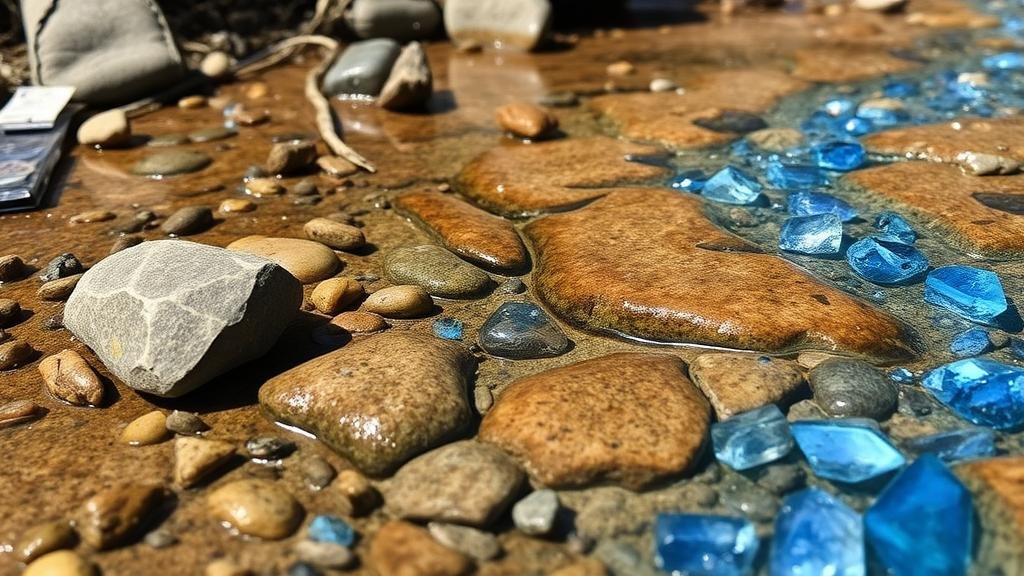Sapphire Streams: Finding Nature’s Blue Gems in Riverbed Sediments
Sapphire Streams: Finding Nature’s Blue Gems in Riverbed Sediments
For rockhounds and mineral collectors, the thrill of discovery often lies in the hunt for precious stones. Among these, sapphires, with their deep blue hues and stunning clarity, are highly sought after. Sapphire streams, where these gems can be found in riverbed sediments, provide an exciting and accessible avenue for enthusiasts to uncover natures treasures.
Understanding Sapphires
Sapphires are a variety of corundum, a mineral composed primarily of aluminum oxide (Al2O3). distinct blue color is due to the presence of iron and titanium during the crystal formation process. Sapphires can also be found in a spectrum of colors, except red, which is classified as ruby. Notably, the quality of sapphires is often assessed based on the following criteria:
- Color: The most desirable sapphires exhibit a vivid blue with good saturation.
- Clarity: Flawless stones are rare; however, minor inclusions can enhance a stones character.
- Cut: Proportionate cuts can enhance brilliance and color perception.
- Carat weight: Larger stones are typically more valuable, although the quality often prevails over size.
The Geology Behind Sapphire Streams
Sapphires typically originate under high temperatures and pressures in metamorphic rocks. As these rocks weather and erode, sapphires make their way into riverbeds. The geological processes that contribute to this include:
- Mechanical Weathering: Physical forces break down rocks, releasing sapphires into the sediment.
- Chemical Weathering: Water interacts with minerals, dissolving some and liberating others, including sapphires.
Streams in areas with known sapphire deposits often possess specific geological formations that can guide collectors. For example, sapphire-bearing regions typically feature igneous rock formations, sedimentary layers that have weathered over time, and the presence of heavy minerals (such as zircon and garnet) that can be indicators of sapphire accumulation.
Where to Find Sapphire Streams
Identifying the right locations is fundamental for successful sapphire hunting. Some renowned sapphire-producing regions include:
- Montana, USA: Known for its incredible quality and diversity of sapphires in the Yellowstone River and its tributaries.
- Australia: Notable areas include Queensland and New South Wales, which have significant alluvial deposits.
- Sri Lanka: Recognized for its blue sapphires, especially the riverbeds around Ratnapura.
In these areas, stream beds and gravel bars can often yield sapphires, particularly after heavy rainfall or flooding, which can shift sediment and expose gems that may have been buried.
Practical Tips for Collectors
For those embarking on the adventure of sapphire collecting, the following tips can enhance your experience:
- Research: Before you head out, research the geology and history of sapphire deposits in the area.
- Essential Gear: Equip yourself with the right tools such as a sieve, shovel, and a container for collected stones.
- Proper Technique: Sifting through sediment in shallow stream beds can be effective. Use water to rinse away lighter materials.
- Identify Potential Finds: Look for stones with a glassy luster and blue coloration; sapphires are typically heavier than quartz.
Real-World Applications and Considerations
Collecting sapphires from riverbeds not only fulfills personal interests but can also have economic benefits. Sapphires are frequently used in jewelry making, and their value can greatly increase with quality and origin. But, its essential to consider ethical sourcing and local regulations when collecting gemstones. Always ensure that you have the proper permits and that you are aware of the environmental impact of your activities.
Conclusion
Finding sapphires in riverbed sediments offers an exhilarating blend of adventure and discovery for rockhounds and mineral collectors. By understanding the geological background, knowing where to look, and employing effective collection techniques, enthusiasts can unearth natures stunning blue gems. Always approach collecting with respect for the environment and local laws, ensuring that this practice can continue to intrigue future generations.
Actionable Takeaway: Equip yourself with knowledge about local geology and sedimentary properties before you venture out, and remember to enjoy the process of discovery as much as the finding!



